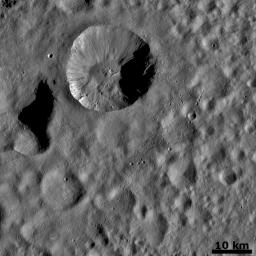
|
Ejecta from a Fresh Crater Covering Older Craters and Crater Chains
- Click the image above for a larger view
- Full-Res JPEG (1024 x 1024) (209.2 kB)
- Full-Res TIFF (1024 x 1024) (1.1 MB)
Caption:
This Dawn FC (framing camera) image is dominated by an approximately 20km wide, young, fresh crater in the top of the image. Surrounding this crater is its ejecta blanket, which is a covering of small particles that were thrown out during the impact that formed the crater. The ejecta blanket is the cause of the smooth surface around the 20km crater in this image. This ejecta blanket buries many older, degraded craters and some can be seen poking through the blanket in the bottom and right of the image. Degraded craters are less clear or not visible directly next to the 20km crater. This suggests that the ejecta blanket is thicker, and consequently more deeply buries older craters, closer to the 20km crater. There are several distinctive chains of small craters running obliquely across the image on top of the ejecta blanket. They are not buried by the ejecta blanket so must be younger than it. These crater chains likely formed due to secondary impacts, when material thrown out of previous impacts re-impacted Vesta. Similarly, material ejected from the 20km crater has fallen back into the crater and created densely packed pits on its floor.
This image is in Vesta's Floronia quadrangle and the center latitude and longitude of the image is 32.5°N, 1.2°E. NASA's Dawn spacecraft obtained this image with its framing camera on October 24th 2011. This image was taken through the camera's clear filter. The distance to the surface of Vesta is 662 km and the image has a resolution of about 62 meters per pixel. This image was acquired during the HAMO (High Altitude Mapping Orbit) phase of the mission.
Background Info:
The Dawn mission to Vesta and Ceres is managed by NASA's Jet Propulsion Laboratory, a division of the California Institute of Technology in Pasadena, for NASA's Science Mission Directorate, Washington D.C. UCLA is responsible for overall Dawn mission science. Dawn's VIR was provided by ASI, the Italian Space Agency and is managed by INAF, Italy's National Institute for Astrophysics, in collaboration with Selex Galileo, where it was built.
More information about Dawn is online at http://www.nasa.gov/dawn and http://dawn.jpl.nasa.gov .
Cataloging Keywords:
| Name | Value | Additional Values |
|---|---|---|
| Target | 4 Vesta | |
| System | Main Belt | |
| Target Type | Asteroid | |
| Mission | Dawn | |
| Instrument Host | Dawn | |
| Host Type | Orbiter | |
| Instrument | Framing Camera (FC) | |
| Detector | ||
| Extra Keywords | Crater, Grayscale, Impact, Infrared | |
| Acquisition Date | ||
| Release Date | 2011-11-10 | |
| Date in Caption | ||
| Image Credit | NASA/JPL-Caltech/UCLA/MPS/DLR/IDA | |
| Source | photojournal.jpl.nasa.gov/catalog/PIA15044 | |
| Identifier | PIA15044 | |
